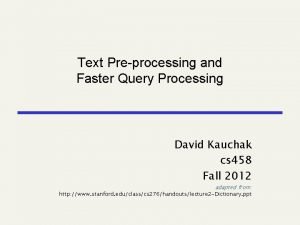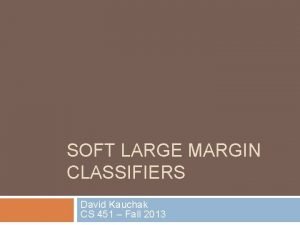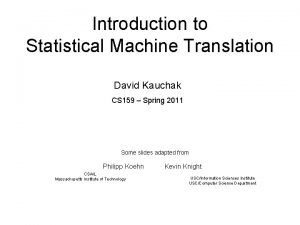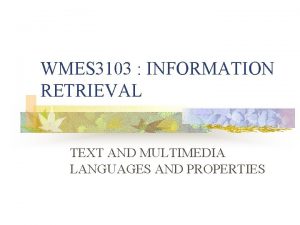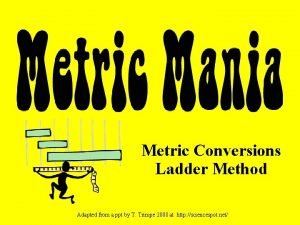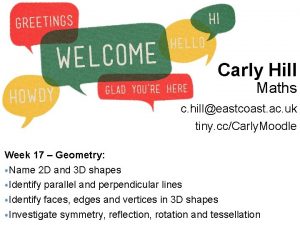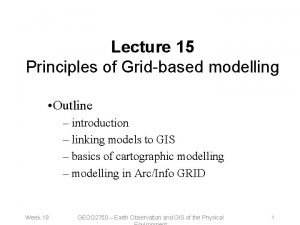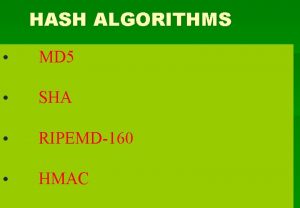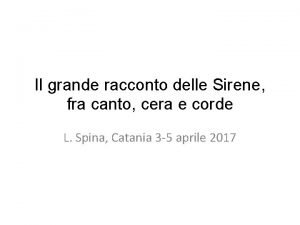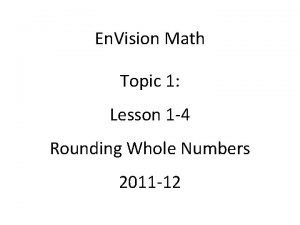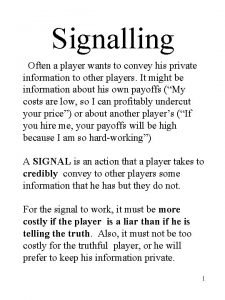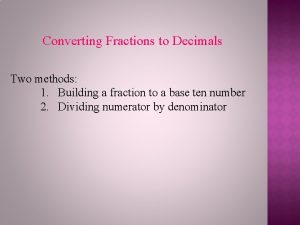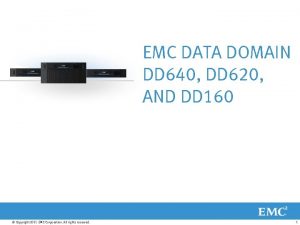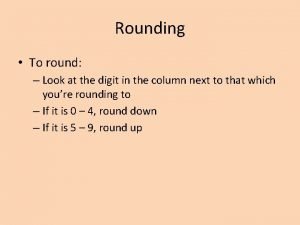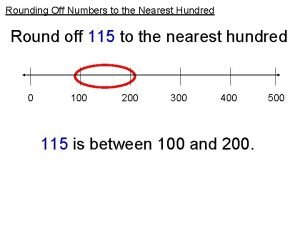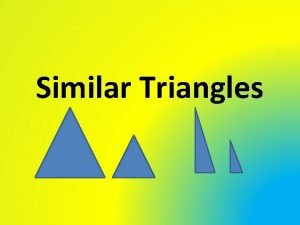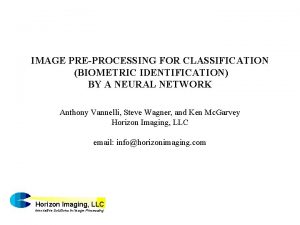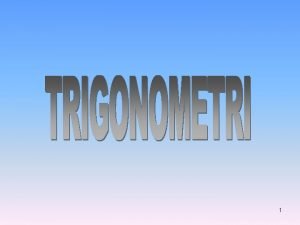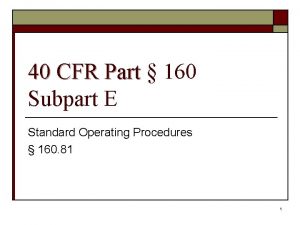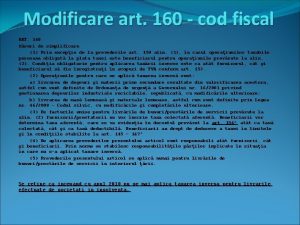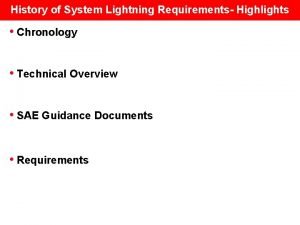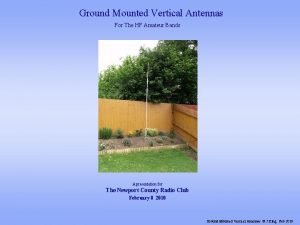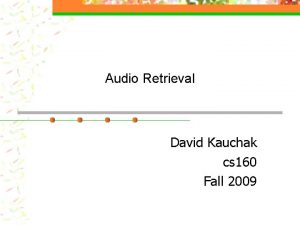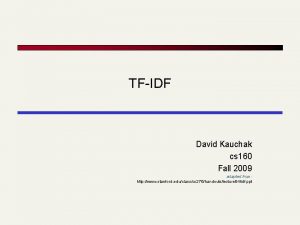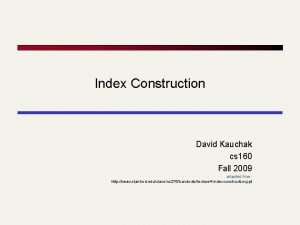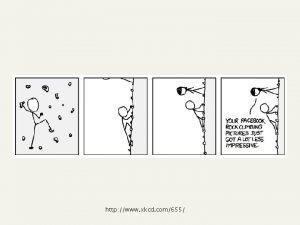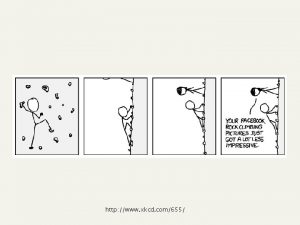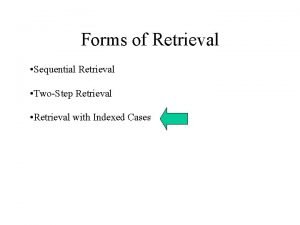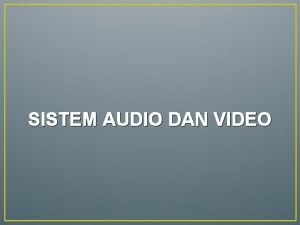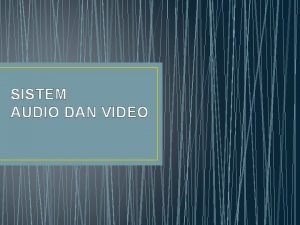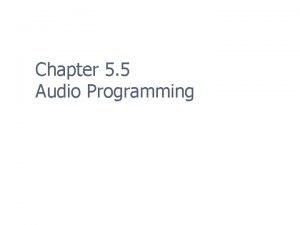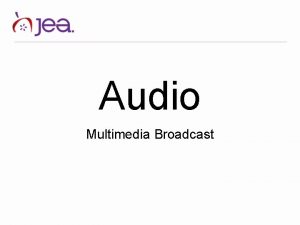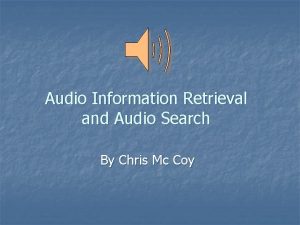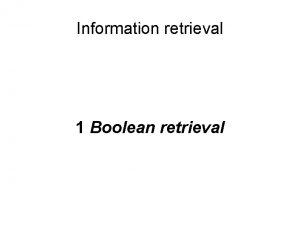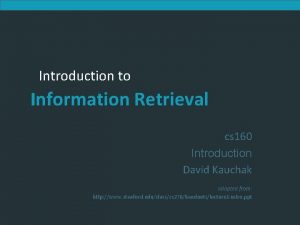Audio Retrieval David Kauchak cs 160 Fall 2009


















































![More surface features n Flux: Spectral change Where, Mp[f] is M[f] of the previous More surface features n Flux: Spectral change Where, Mp[f] is M[f] of the previous](https://slidetodoc.com/presentation_image_h2/100f79bb663f64e02de3e4b283bdba2f/image-51.jpg)







- Slides: 58

Audio Retrieval David Kauchak cs 160 Fall 2009

Administrative Assign 4 due Friday n Previous scores n

Final project

Audio retrieval text retrieval corpus audio retrieval corpus

Current audio search engines

What do you want from an audio search engine? n n n Name: You might know the name of the song or the artist Genre: You might try “Bebop, ” “Latin Jazz, ” or “Rock” Instrumentation: The tenor sax, guitar, and double bass are all featured in the song Emotion: The song has a “cool vibe” that is “upbeat“ with an “electric texture” Some other approaches to search: n n n musicovery. com pandora. com (song similarity) Genius (collaborative filtering)

Text Index construction Friends, Romans, countrymen. Documents to be indexed text preprocessing friend , roman , countrymen. indexer Inverted index friend 2 4 roman 1 2 countryman 13 16

Audio Index construction Audio files to be indexed wav mp 3 midi audio preprocessing Today slow, jazzy, punk indexer may be keyed off of text Index may be keyed off of audio features

Sound n What is sound? n n n A longitudinal compression wave traveling through some medium (often, air) Rate of the wave is the frequency You can think of sounds as a sum of sign waves

Sound n How do people hear sound? n The cochlea in the inner ear has hair cells that "wiggle" when certain frequency are encountered http: //www. bcchildrens. ca/NR/rdonlyres/8 A 4 BAD 04 -A 01 F-4469 -8 CCF-EA 2 B 58617 C 98/16128/theear. jpg

Digital Encoding n n Like everything else for computers, we must represent audio signals digitally Encoding formats: n n WAV MIDI MP 3 Others…

WAV n n Simple encoding Sample sound at some interval (e. g. 44 KHz). High sound quality Large file sizes

MIDI Musical Instrument Digital Interface n MIDI is a language n Sentences describe the channel, note, loudness, etc. n 16 channels (each can be thought of and recorded as a separate instrument) n Common for audio retrieval and classification applications n

MP 3 n n n Common compression format 3 -4 MB vs. 30 -40 MB for uncompressed Perceptual noise shaping n n The human ear cannot hear certain sounds Some sounds are heard better than others The louder of two sounds will be heard Lossy or lossless? n n n Lossy compression quality depends on the amount of compression like many compression algorithms, can have issues with randomness (e. g. clapping)

MP 3 Example

Features Weight vectors - word frequency - count normalization - idf weighting - length normalization ?

Tools for Feature Extraction Fourier Transform (FT) n Short Term Fourier Transform (STFT) n Wavelets n

Fourier Transform (FT) n Time-domain Frequency-domain

Another FT Example Time Frequency

Problem?

Problem with FT FT contains only frequency information n No time information is retained n Works fine for stationary signals n Non-stationary or changing signals cause problems n n FT shows frequencies occurring at all times instead of specific times Ideas?

Short-Time Fourier Transform (STFT) n n n Idea: Break up the signal into discrete windows Treat each signal within a window as a stationary signal Take FT over each part …

STFT Example amplitude time frequency

STFT Example

Problem: Resolution How do we pick the window size? n We can vary time and frequency accuracy n n n Narrow window: good time resolution, poor frequency resolution Wide window: good frequency resolution, poor time resolution

Varying the resolution Ideas?

Wavelets

Wavelets n Wavelets respond to signals that are similar

Wavelet response A wavelet responds to signals that are similar to the wavelet ?

Wavelet response Scale matters! ?

Wavelet Transform Idea: Take a wavelet and vary scale n Check response of varying scales on signal n

Wavelet Example: Scale 1

Wavelet Example: Scale 2

Wavelet Example: Scale 3

Wavelet Example Scale = 1/frequency Translation Time

Discrete Wavelet Transform (DWT) Wavelets come in pairs (high pass and low pass filter) n Split signal with filter and downsample n

DWT cont. n Continue this process on the low frequency portion of the signal

DWT Example signal low frequency high frequency

How did this solve the resolution problem? n n Higher frequency resolution at high frequencies Higher time frequency at low frequencies

Feature Extraction n n All these transforms help us understand how the frequencies changes over time Features extraction: n Mel-frequency cepstral coefficients (MFCCs) n n Surface features (texture, timbre, instrumentation) n n Attempt to mimic human ear Capture frequency statistics of STFT Rhythm features (i. e the “beat”) n Characteristics of low-frequency wavelets


Music Classification n Data n Audio collected from radio, CDs and Web n n n Genres: classic, country, hiphop, jazz, rock Speech vs. music 4 -types of classical music 50 samples for each class, 30 sec. long Task is to predict the genre of the clip Approach n n Extract features Learn genre classifier

General Results Music vs. Speech Genres Classical Random 50% 16% 25% Classifier 86% 62% 76%

Results: Musical Genres Classic Country Disco Hiphop Classic 86 2 0 4 18 1 Country 1 57 5 1 12 13 Disco 0 6 55 4 0 5 Hiphop 0 15 28 90 4 18 Jazz 7 1 0 0 37 12 Rock 6 19 11 0 27 48 Pseudo-confusion matrix Jazz Rock

Results: Classical Choral Orchestral Piano Choral 99 0 1 Orchestral 10 53 20 Piano 16 2 75 String 12 5 3 String 0 17 7 80 Confusion matrix

Google Books

Thanks n Robi Polikar for his old tutorial (http: //www. public. iastate. edu/~rpolikar/WAVELETS/WTtutorial. html)

Musical surface features n What we’d like to do: n Represents characteristics of music n n n Texture Pitch Timbre Instrumentation We need to quantify these things n Statistics that describe frequency distribution n n Average frequency Shape of the distribution Number zero Crossings Rhythm features

Calculating Surface Features Signal Divide into windows FFT over window Calculate feature for window Calculate mean and std. dev. over windows …

Surface Features n Centroid: Measures spectral brightness n Rolloff: Spectral Shape R such that: M[f] = magnitude of FFT at frequency bin f over N bins
![More surface features n Flux Spectral change Where Mpf is Mf of the previous More surface features n Flux: Spectral change Where, Mp[f] is M[f] of the previous](https://slidetodoc.com/presentation_image_h2/100f79bb663f64e02de3e4b283bdba2f/image-51.jpg)
More surface features n Flux: Spectral change Where, Mp[f] is M[f] of the previous window Zero Crossings: Noise in signal n Low Energy: Percentage of windows that have energy less than average n

Rhythm Features Wavelet Transform Full Wave Rectification Low Pass Filtering Downsampling Normalize

Rhythm Features cont. Autocorrelation – The cross-correlation of a signal with itself (i. e. portions of a signal with it’s neighbors) Take first 5 peaks Histogram over windows of the signal

Actual Rhythm Features n Using the “beat” histogram… n n n Period 0 - Period in bpm of first peak Amplitude 0 - First peak divided by sum of amplitude Ratio. Period 1 - Ratio of periodicity of first peak to second peak Amplitude 1 - Second peak divided by sum of amplitudes Ratio. Period 2, Amplitude 2, Ratio. Period 3, Amplitude 3

Analysis of Features

GUI for Audio Classification n Genre Gram n n Graphically present classification results Results change in real time based on confidence Texture mapped based on category Genre Space n n n Plots sound collections in 3 -D space PCA to reduce dimensionality Rotate and interact with space

Genre Gram

Genre Space
 David kauchak
David kauchak Lebensversicherungsgesellschaftsangestellter
Lebensversicherungsgesellschaftsangestellter David kauchak
David kauchak David kauchak
David kauchak David kauchak
David kauchak Translation process
Translation process Cs 451
Cs 451 Audio retrieval
Audio retrieval Spoken language audio retrieval in irs
Spoken language audio retrieval in irs Introduction to teaching kauchak
Introduction to teaching kauchak Metric ladder
Metric ladder Smt160-30
Smt160-30 160/60
160/60 6280/160
6280/160 Hmac-ripemd160
Hmac-ripemd160 Parafrasi il canto delle sirene dal verso 160
Parafrasi il canto delle sirene dal verso 160 160 ke
160 ke 160 euros
160 euros Round 160 656 to the nearest hundred thousand
Round 160 656 to the nearest hundred thousand 160/60
160/60 Exforge 160/10 prix maroc
Exforge 160/10 prix maroc 160*3/60
160*3/60 160 fifth avenue nyc
160 fifth avenue nyc Write the ratio as a percent. 160:400
Write the ratio as a percent. 160:400 180000/160
180000/160 Rd n° 160-2015/digesa/sa
Rd n° 160-2015/digesa/sa 12vac35-105-620
12vac35-105-620 As heavy as
As heavy as Capr 160-1
Capr 160-1 6280/160
6280/160 Data domain 160
Data domain 160 Rounding marks letuscrack
Rounding marks letuscrack 160/60
160/60 650 rounded to the nearest hundred
650 rounded to the nearest hundred 1600000/160
1600000/160 100+120+140+160+180
100+120+140+160+180 What does it mean
What does it mean 160 161
160 161 20 square feet of opaque plastic sheeting
20 square feet of opaque plastic sheeting 512 x 160
512 x 160 Ecomagination
Ecomagination Wac 296-800-160
Wac 296-800-160 160/60
160/60 Sin½
Sin½ 40 cfr 160
40 cfr 160 160-137
160-137 La ley 160 de 1994
La ley 160 de 1994 Hasil pengukuran panjang sebuah torak adalah 15 2435 cm
Hasil pengukuran panjang sebuah torak adalah 15 2435 cm Art 160 cod fiscal
Art 160 cod fiscal Cbe 160
Cbe 160 32 nin 24 fazlası kaçtır
32 nin 24 fazlası kaçtır El doble del exceso de un numero aumentado en 5
El doble del exceso de un numero aumentado en 5 Konica minolta bizhub 160
Konica minolta bizhub 160 çokgende köşegen sayısı
çokgende köşegen sayısı Rtca do 160 section 22
Rtca do 160 section 22 Partes
Partes Anticorps anti nucléaire moucheté 1/160
Anticorps anti nucléaire moucheté 1/160 43 foot vertical on 160 meters
43 foot vertical on 160 meters Psalm 119:160
Psalm 119:160

